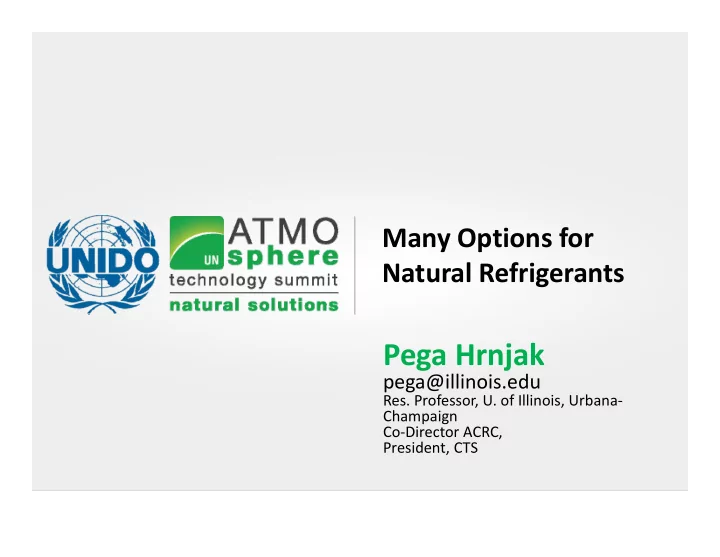

Many Options for Natural Refrigerants Pega Hrnjak pega@illinois.edu Res. Professor, U. of Illinois, Urbana ‐ Champaign Co ‐ Director ACRC, President, CTS
P. Hrnjak 2/19 Natural refrigerants • In vapor compression systems: – Ammonia: R717 Serious potential to become – Hydrocarbons: R600a, R290, …. mainstream option – Carbon Dioxide: R744 – Air: R729 (aircrafts, low temperatures,..) – Water: R718 – low pressures and large equipment per capacity – Helium (Stirling) – cooling issues, niche applications • In absorption systems: (niche applications, inexpensive heat) – Ammonia – water • In ejector systems: (when steam is almost free) – Steam • Other niche refrigeration options : – Magnetic, acoustic, electrochemical, …
P. Hrnjak 3/19 Current advances • Hermetic compressor 270 mm 270 mm 270 mm • Microchannel condenser • Ni brazed plate evaporator 700 mm 700 mm 700 mm Needed: Cost reduction - Different materials: aluminum as an option
P. Hrnjak 4/19 Ammonia • The only natural refrigerant that was continuously in use (in industrial refrigeration) • Not appropriate for populated areas when charge is significant • Low charge chillers for a/c or refrigeration with secondary coolant or cascade • Lowest published charge 18 g/kW@15kW, ‐ aircooled
P. Hrnjak 5/19 Hydrocarbons • The lowest cost alternative • Almost drop ‐ in replacement for R22 (R290) – a/c or commercial refrigeration • Easy replacement for R12 or R134a (R600a) – refrigerators • Flammable • Charge limits 50g (?) or 150 g (?) • Lowest charge known: 48g/kW @ 1kW, aircooled
P. Hrnjak 6/19 Carbon Dioxide • Very old refrigerant • Abandoned because of high pressures and bulkiness of components • Microchannel HXs and better materials reopen the door • Winning applications: HPWH, bottle coolers, commercial refrigeration (supermarkets) • Automotive applications reconsidered • Assumed to be low efficient refrigerant – new systems high efficiency
P. Hrnjak 7/19 Just a few words about Efficiency (COP) because many think that CO 2 is not efficient Very often same word is used for different efficiencies: 1. Cycles ( refrigerants ) 2. Systems (add effects of components ) 3. In application (add effects of operation )
P. Hrnjak 8/19 Cycle analysis • Use tools of Thermodynamics: – Cycle analysis – determines efficiency – Thermodynamic properties of the fluid – Second law (entropy generation) • Ignores realities of HX and Cp design: heat transfer, pressure drop, local sink and source change in temperature, fluid interactions, controls, … • Attractive because it is “clean” • Just appears to be unbiased if pretends to give the complete answer • Excellent to evaluate options, as the first of the steps
P. Hrnjak 9/19 Carnot cycle Isentropic Isentropic Condenser T expander compressor Evaporator T cd T sink W T source T evap Q evap s Q cd =T cd * s s Q evap =T evap * s Carnot cycle – ideal • W= Q cd ‐ Q evap =(T cd ‐ T evap )* s – Reversible (DT=0, friction=0, slow,…) COP= Q evap /W • All fluids are equal!
P. Hrnjak 10/19 So, • ALL REFRIGERANTS ARE EQUALLY EFFICIENT IN CARNOT CYCLE • They start to differ when designers move a bit away from Carnot for technical reasons • Let’s have a quick reminder:
P. Hrnjak 11/19 Rankine (Evans ‐ Perkins) cycle Condenser T Isenthalpic expansion T cd T sink Isentropic W compressor T source T evap Q evap Evaporator s COP= Qevap/W • Rankine – Dry suction, Isenthalpic expansion • Fluids are NOT equal – begin to differentiate
P. Hrnjak 12/19 When reality of HXs, compressor, expansion devices come into a play • This is when THERMOPHYSICAL properties become way more important that THERMODYNAMIC properties • That is where CO 2 and typically all natural refrigerants are good
P. Hrnjak 13/19 System, based on Rankine cycle Takes in account realities of: heat exchangers, compressors, expansion devices Tcao Tcro_sat T Tcai Tcro_sat T T cai sink Teai Real T T eai source compressor Teao Tero_sat Teao Tero_sat s Rankine system – measured on the test bench
P. Hrnjak 14/19 In p ‐ h (t e =0 o C, t cd =30 o C)
P. Hrnjak 15/19 In scale: p ‐ h
P. Hrnjak 16/19 Why is this important? • COPs of the CYCLE is dramatically reduced in the SYSTEM by effect of: – Heat transfer (thermophysical properties of the fluid) – Heat exchanger design – Compressor design and manufacturing – Expansion device (work recovery) – System architecture (two stage compression, IHX, subcooling, ….) • Good selection can totally change initial expectations
P. Hrnjak 17/19 Situation • R744 is very different than R134a, R717, or R290 • Has to be treated as such • Possible but more difficult to achieve higher COPs • Better thermophysical properties – heat transfer advantages have to be utilized • Lesser sensitivity to pressure drop – easier to make HXs
P. Hrnjak 18/19 Also excellent for charge reduction Example: equal Q =1kW DP causes 1% COP reduction ∆ P Mass Sat. Sat. COP Ref. Hydraulic Cond. Rejected Latent Fluid Flow Liquid Vapor [1 % COP Mass Diameter Temp. Heat Heat Ideal Rate Density Density reduction] [g] [mm] [g/s] [kPa] [ ‐ ] [C] [kW] [kg/m 3 ] [kg/m 3 ] [kJ/kg] 13.4 0.8625 0.862 7.45 10.04 24.6 1.043 603.9 7.72 1169 R717 29.8 0.586 5.943 35.79 7.01 24.3 1.103 724.8 234.7 125.9 R744 R290 34.4 1.14 3.150 6.58 9.57 25.2 1.048 492.2 20.72 335.7 44.9 0.915 3.636 11.46 9.41 24.8 1.054 962.8 47.12 271.7 R32 59.1 1.606 3.310 3.17 9.76 25.5 1.067 550.2 9.285 329.4 R600a 65.6 0.975 5.320 11.65 9.37 25.1 1.067 1063 66.15 187.8 R410A 124.2 1.38 5.962 5.52 9.54 25.6 1.094 1206 32.88 177.7 R134a 132 1.464 7.520 5.41 9.31 25.6 1.077 1091 38.42 145.6 R1234yf
P. Hrnjak 19/19 Conclusion • Each of the main alternatives are excellent and competitive. • Need to be treated with understanding to maximize opportunities. • Main issue: how to overcome initial higher cost
Thank you very much for your attention
Recommend
More recommend